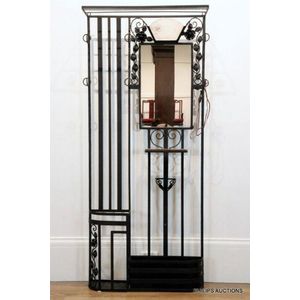Art Deco Hall Stand by Henri Mouynet
A French Art Deco wrought iron hall stand by Henri Mouynet, circa 1930 with a long mirror surmounted by a frosted glass fan shaped panel signed 'H Mouynet' and fitted with a light, flanked by finely worked slender textured splats with scrolling terminals and sprays of roses, with a small mottled brown marble shelf and drip trays to the lower register. Height 188 cm, width 80 cm, depth 20 cm
You must be a subscriber, and be logged in to view price and dealer details.
Subscribe Now to view actual auction price for this item
When you subscribe, you have the option of setting the currency in which to display prices to $Au, $US, $NZ or Stg.
This item has been sold, and the description, image and price are for reference purposes only.
- Circa - A Latin term meaning 'about', often used in the antique trade to give an approximate date for the piece, usually considered to be five years on either side of the circa year. Thus, circa 1900 means the piece was made about 1900, probably between 1895 and 1905. The expression is sometimes abbreviated to c.1900.
- Art Deco Period - The Art Deco period was a cultural movement that emerged in the 1920s and 1930s, and was characterized by its emphasis on modernism, luxury, and elegance. The name "Art Deco" comes from the Exposition Internationale des Arts Décoratifs et Industriels Modernes, a large exhibition held in Paris in 1925 that showcased the latest trends in decorative arts.
Art Deco was a reaction against the ornate and elaborate styles of the previous era, and reflected a new modern sensibility. It was characterized by streamlined, geometric shapes, bright colours, and the use of new materials such as chrome, glass, and Bakelite. Art Deco designers sought to create a sense of luxury and sophistication, often incorporating expensive materials such as ivory, marble, and rare woods.
Art Deco had a significant impact on a wide range of artistic fields, including architecture, fashion, graphic design, and interior design. Some of the most iconic examples of Art Deco architecture include the Empire State Building in New York City, the Hoover Building in London, and the Palais de Chaillot in Paris.
The Art Deco period came to an end in the 1940s, as World War II and changing cultural trends led to a shift in artistic styles. However, Art Deco remains an important influence on design and art, and continues to be celebrated for its modernist sensibility and glamorous aesthetic. - Signed or Stamped - A signed piece of furniture may mean that the maker has signed (and hopefully dated) the piece in the same way that we sign a cheque, but more likely, that it bears evidence of the name of the maker, wholesaler or retailer as a paper label, metal plaque, impressed into the timber or in later pieces after about 1880, stamped onto the timber with an ink stamp.
The 'signature' or stamp will always be in an unobtrusive position: under the top of a table, on the underside of the rails of a chair, inside a drawer or on the back.
The fact that a piece is 'signed' considerably enhances its value. Signed Australian furniture is extremely rare, and for imported furniture, it is a mark of quality of the item, as only the items by the top makers or retailers were 'signed'
This item has been included into following indexes:
